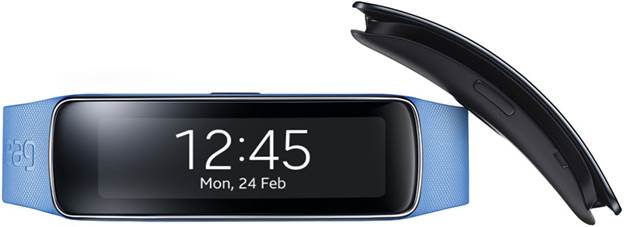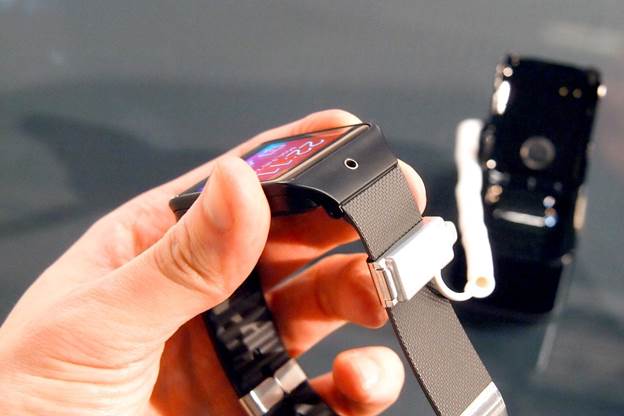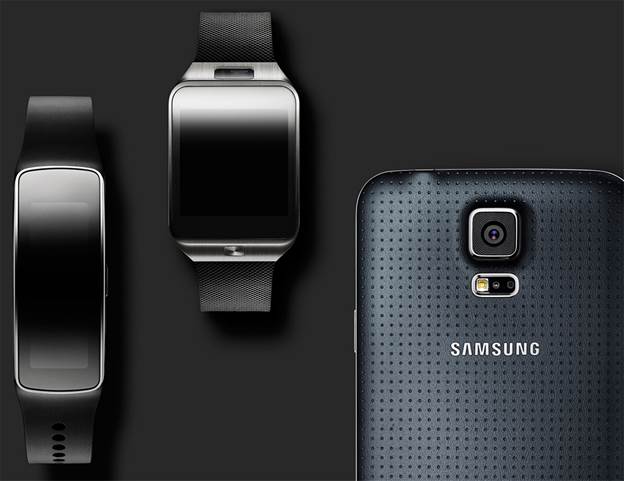On the plus side, a number of useful native
apps are included, such as a media controller, sleep tracker, and native music
player. The watch also has a built-in IR blaster, which you can use to control
your TV, although don’t expect to do anything fancy as this is mainly limited
to changing the channel and volume.

The
Samsung Gear Fit features 1.84” curved super AMOLED (432*128 resolution) screen
as well as integrated accelerometer, gyro and heart rate sensors. The
smart-band features integrated pedometer, exercise, heart rate, sleep,
stopwatch and timer micro-applications. The device can notify people about
incoming calls, emails, SMS, alarm, S-planner, 3rd party apps and so on.
The most exciting new feature is the
Exercise app, which is basically a stripped-down version of the S Health app
found on the Galaxy S5. Tell the app what kind of exercise you’re doing -
walking, jogging, hiking, or bike riding - and it will automatically track your
heart rate, distance travelled and calories burned. In our testing, the
pedometer seemed accurate enough, but the heart rate monitor was hit or miss.
Any movement or even noise often resulted in a failure message, and back to
back readings can fluctuate quite wildly, which raises some concerns over its
accuracy.

Samsung
Gear 2 is resistant to dust and water which is IP67 certified so that you don't
have to feel limited by rough conditions or unpredictable weather.
The Galaxy Gear’s camera module was one of
the unique features that set it apart from other smartwatches and the Gear 2
remains one of the few on the market with a built-in camera. Unfortunately, the
2MP module is just a negligible improvement over the 1.9MP shooter from the first
Gear and there’s still not very much you can do with it. I found it occasionally
useful for taking quick snapshots of things when quality isn’t a concern - like
remembering a website URL – but other than that, it’s generally a better idea
to whip out your smartphone.
One of the biggest problems with the
original Gear was its horrendous battery life, estimated by Samsung itself as
“about a day”. Surprisingly, despite the Gear 2 being fitted with an even
smaller battery, battery life is actually much improved and I only had to
recharge the watch after about three days - although this is still a bit too
often for convenience.

The
Samsung Gear 2 and Gear 2 Neo are companion devices that allow users to accept
or ignore incoming calls and messages as well as provide instant notification
options based on a user’s activity and habits. Samsung Gear 2-series feature
1.63” display (superAMOLED, 320*320 resolution), dual-core 1GHz processor,
512MB RAM, Tizen-based operating system, 4GB of NAND flash storage, heart-rate
sensor, pedometer, accelerometer, gyroscope as well as Bluetooth v4.0 LE and
IrLED connectivity to connect to other mobile devices and control TVs.
Overall, while the Gear 2 is a big
improvement over the original, it just doesn’t do anything well enough to
justify its $398 price. If Samsung could somehow squeeze a smartphone quality
camera into the next Gear, it might have a unique killer feature, but right now
the camera is still a novelty. Its exercise features are usable, but the heart
rate monitor doesn’t seem accurate enough, and if fitness is your top priority,
you’re probably better off with a lighter, dedicated fitness band. If you
really have to get one, opt for the all-plastic, camera-less Gear 2 Neo
instead, which is essentially the same, but at a much lower price of $298.